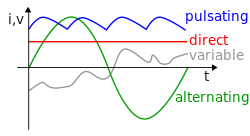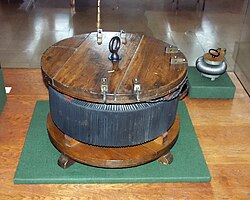Alternating current

An alternating current (AC) is an electric current of which magnitude and direction vary, unlike direct current, whose direction remains constant. This means that the direction of current flowing in a circuit is constantly being reversed back and forth. This is done with any type of AC voltage source.
The usual waveform of an AC power circuit is a sine wave, because this leads to the most efficient transmission of energy. However, in certain applications different waveforms are used, such as triangular or square waves. Inexpensive power inverters produce a square wave with a pause between the change in direction.
When one speaks of alternating current one mostly refers to the form in which electricity is delivered to businesses and residences. The AC comes from a power plant. The direction of the electricity switches back 60 times every second (or 50 times in some parts of the world). This happens so fast that a light bulb does not stop glowing.[1]
Both audio and radio signals carried on electrical wire are also examples of alternating current. In these applications, an important goal is often the recovery of information encoded (or modulated) onto the AC signal.
History
Nikola Tesla experimented with electrical resonance and studied various lighting systems. He invented an induction motor, new types of generators and transformers, and a system of alternating current power transmission.[2]
William Stanley, Jr. designed one of the first practical devices to transfer AC power efficiently between isolated circuits. Using pairs of coils wound on a common iron core, his design, called an induction coil, was an early precursor of the modern transformer. The system used today was devised in the late nineteenth century, largely by Nikola Tesla. Contributions were also made by George Westinghouse, Lucien Gaulard, John Dixon Gibbs,Wilhelm Siemens and Oliver Shallenger. AC systems overcame the limitations of the direct current system used by Thomas Edison to distribute electricity efficiently over long distances.
The Mill Creek hydroelectric plant was built near Redlands, California in 1893. Designed by Almirian Decker, it used 10,000 volt three-phase electric power which eventually became the standard method for power stations throughout the world.
How it Works
AC power is cheaper and easier to make electronic devices. The power switches for AC power are also less expensive to make. It is less expensive than DC because you can increase and decrease the current very easily. AC can use high voltages with smaller current to reduce losses when you send power. AC reduces the heating in the wires. DC power could be sent, but it would lose a lot of energy and you would have to put more work in it to send it great distances. AC transformers are installed everywhere, including atop utility poles and underground. Alternating current works by switching the current many times back and forth constantly while it goes back to the source it came from.[3]
Further reading
- Willam A. Meyers, History and Reflections on the Way Things Were: Mill Creek Power Plant - Making History with AC, IEEE Power Engineering Review, February 1997, Pages 22–24
Alternating Current Media
A schematic representation of long distance electric power transmission. From left to right: G=generator, U=step-up transformer, V=voltage at beginning of transmission line, Pt=power entering transmission line, I=current in wires, R=total resistance in wires, Pw=power lost in transmission line, Pe=power reaching the end of the transmission line, D=step-down transformer, C=consumers.
Three-phase high-voltage electric power transmission lines use alternating currents to distribute power over long distances between electric generation plants and consumers. The lines in the picture are located in eastern Utah.
A sinusoidal alternating voltage.Template:Ordered list*
A sine wave, over one cycle (360°). The dashed line represents the root mean square (RMS) value at {\sqrt {0.5}} (about 0.707).
The Hungarian ZBD Team (Károly Zipernowsky, Ottó Bláthy, Miksa Déri), inventors of the first high efficiency, closed-core shunt connection transformer
References
- ↑ "Alternating current". Archived from the original on 21 April 2012. Retrieved 24 May 2012.
- ↑ "Nikola Tesla". 1996. Archived from the original on 3 March 2015. Retrieved 27 May 2012.
- ↑ "Electricity & Magnetism: Alternating Current". 1997–2012. Retrieved 25 May 2012.
Related pages
Other websites
- What is alternating current (AC)? - on All About Circuits
- "AC/DC: What's the Difference Archived 2014-12-30 at the Wayback Machine?". Edison's Miracle of Light, American Experience Archived 2009-01-16 at the Wayback Machine. (PBS)
- "AC/DC: Inside the AC Generator Archived 2014-12-28 at the Wayback Machine". Edison's Miracle of Light, American Experience. (PBS)
- Kuphaldt, Tony R., "Lessons In Electric Circuits : Volume II - AC". March 8, 2003. (Design Science License)
- Nave, C. R., "Alternating Current Circuits Concepts". HyperPhysics.
- "Alternating Current (AC)". Magnetic Particle Inspection, Nondestructive Testing Encyclopedia.
- "Alternating current Archived 2005-10-28 at the Wayback Machine". Analog Process Control Services.
- Hiob, Eric, "An Application of Trigonometry and Vectors to Alternating Current". British Columbia Institute of Technology, 2004.
- "Introduction to alternating current and transformers". Integrated Publishing.
- "Wind Energy Reference Manual Part 4: Electricity Archived 2009-08-30 at the Wayback Machine". Danish Wind Industry Association, 2003.
- Chan. Keelin, "Alternating current Tools Archived 2013-10-29 at the Wayback Machine". JC Physics, 2002.
- "Measurement -> ac Archived 2005-04-15 at the Wayback Machine". Analog Process Control Services.
- Williams, Trip "Kingpin", "Understanding Alternating Current, Some more power concepts".
- "Table of Voltage, Frequency, TV Broadcasting system, Radio Broadcasting, by Country Archived 2008-09-19 at the Wayback Machine".
- Professor Mark Csele's tour of the 25 Hz Rankine generating station Archived 2008-06-17 at the Wayback Machine
- 50/60 hertz information Archived 2008-09-08 at the Wayback Machine
- AC circuits Animations and explanations of vector (phasor) representation of RLC circuits
- Blalock, Thomas J., "The Frequency Changer Era: Interconnecting Systems of Varying Cycles Archived 2007-06-07 at the Wayback Machine". The history of various frequencies and interconversion schemes in the US at the beginning of the 20th century
- "NationalHighMagneticFieldLaboratory-AlternatingCurrentTutorial". 1995–2012. Archived from the original on 22 July 2012. Retrieved 24 May 2012.






